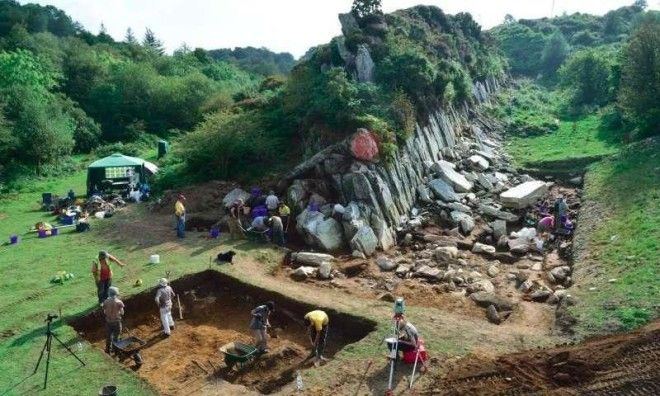Now, researchers think that they have found the exact site from which the massive monoliths were taken, and discovered something intriguing in the process. It seems that Stonehenge might have been erected first in Wales.
Stonehenge is actually formed of two circles. The larger outer stones are made from the local sandstone, but the inner “bluestones,” evidence suggests, originate from the Preseli hills in Pembrokeshire, Wales, which is 140 kilometers (87 miles) from where they now stand. A new paper published in the journal Antiquity pinpoints two separate sites from which the blue stones were taken, based on their geological make-up.

The excavation site at Crag Rhos-y-felin.
The first is an outcrop called Carn Goedog, while the second is known as Crag Rhos-y-Felin. Beneath this second outcrop, the researchers even found the remains of a Neolithic camp site, thought to have been used by the people who quarried the stone. By carbon dating the remains of burnt hazelnuts and charcoal found in the remnants of the campfires, the team have managed to calculate when the stones were first mined. The results indicate that Stonehenge might have actually stood for 500 years before it made its way to Salisbury.
“We have dates of around 3400 B.C.E. for Craig Rhos-y-felin and 3200 B.C.E. for Carn Goedog, which is intriguing because the bluestones didn't get put up at Stonehenge until around 2900 B.C.E.,” explained Professor Mike Parker Pearson, director of the project which made the discovery. “It could have taken those Neolithic stone-draggers nearly 500 years to get them to Stonehenge, but that's pretty improbable in my view. It's more likely that the stones were first used in a local monument, somewhere near the quarries, that was then dismantled and dragged off to Wiltshire.”

Not only has this research discovered that the iconic monument might have been recycled, but it also challenges one of the long-held beliefs of how the ancient peoples got it to Wiltshire all those thousands of years ago. Previous archaeologists have suggested that the giant stones were taken south to the sea, and then transported by boat to nearer their resting place, but this now seems unlikely. The location of the two outcrops means that it would have been difficult to take the rocks south by the sea, meaning that the only logical route would have been to move them east over the land for the 140 kilometer (87 miles) journey; an impressive, but not impossible, feat 4,000 years ago.
The researchers suspect that the original site for where the stones might have stood is probably somewhere in between the two outcrops in the Preseli hills, and plan on returning next year to see if they can identify it. “Stonehenge was a Welsh monument from its very beginning,” says Professor Parker Pearson. “If we can find the original monument in Wales from which it was built, we will finally be able to solve the mystery of why Stonehenge was built and why some of its stones were brought so far.”

